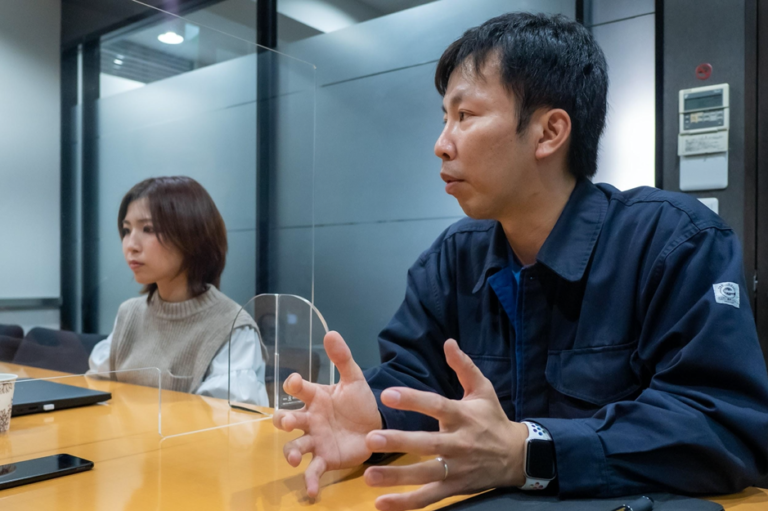With globalization and digitalization advancing worldwide, and society changing rapidly and unpredictably, the emphasis has shifted from the ability to answer questions that have answers accurately and quickly to the ability to tackle complex and difficult-to-answer problems. In order to nurture this ability, inquiry learning is being promoted in school education. Inquiry learning is learning in which students set their own problems, collect, organize, and analyze information to solve them, and exchange opinions and collaborate with others around them.
The new curriculum guidelines set by the Ministry of Education, Culture, Sports, Science and Technology (MEXT) are starting in 2020 for elementary schools, in 2021 for junior high schools, and in 2022 for senior high schools in Japan.
The Ministry of Economy, Trade and Industry(METI) also sees human resource development as important for Japan to create new value and innovation, and is promoting the Classroom of the Future in cooperation with schools and companies nationwide to demonstrate new learning methods utilizing various EdTech under the new Courses of Study.
In response to this trend, several examples of the use of the new technology of 360-degree cameras for inquiry-based learning have begun to emerge. Therefore, in this article, we would like to introduce two examples: examples of children learning with a 360-degree camera and examples of learning with teaching materials created using 360-degreeimages.
First, one of the examples of children's learning with 360-degree cameras is making a disaster prevention map with a virtual tour using a 360-degree camera.
Since schools are often used as evacuation sites in the event of a major earthquake or a large typhoon, the route to the evacuation site is captured by a 360-degree camera, and the captured locations are connected to create a virtual tour of the evacuation route to the school. Dangerous places and points of caution are then written in the 360-degreeimages using the annotation function. The key learning point here is that the children, along with their group members, can check the evacuation route and ask themselves, Where are the dangerous places? and Where are the points of caution? The key point of the study here is the process in which the children, together with their group members, think about and discuss these questions. If the disaster prevention map is posted on the school's website, it will be useful information for local residents, thus killing two birds with one stone.
Next, in the Examples of learning with teaching materials created using 360-degree images, examples of subjects where360-degree images can be effectively used include science, biology, and English. For example, in science, a 360-degree image of a park scene and two directional magnets pointing in different directions can be used to answer the question, Which directional magnet is correct? The key learning point here is the process of finding clues and solving the question by deriving east, west, north, south, and west from the direction of the clocks and shadows in the360-degree image of the park scene.
In the Biology category, students can develop their ability to observe and to derive answers by accumulating knowledge in a complex manner, for example, by using plants and insects in the360-degree images as clues to identify the areas where the images were taken.
In the English section, users can use360-degree images of a coffee shop to order in English using the menu, seating, and other information in the images, check the interior of the store, and ask for directions while using 360-degree images of the city.
While ordinary photographs provide limited information in two dimensions, and the composition of the image is determined by the photographer's intent, 360-degree photographs, which are not in two dimensions, are suitable for inquiry-based learning, as they allow the viewer to select from a large amount of information and gain insights from the information captured.
The Ministry of Education, Culture, Sports, Science and Technology (MEXT) is considering the introduction of digital textbooks, and is also considering the use of virtual reality (VR) for hands-on learning. It is expected to promote active learning, in which students ask questions on their own instead of passive learning. It is also expected to promote comprehension and stimulate the brain through a sense of immersion, there by increasing motivation for learning.
In addition to this, by incorporating VR, students can remotely conduct social studies tours, learn about social issues in developing countries through 360-degree images, and broaden their perspectives through realistic experiences.
We expect to see more and more use of360-degree cameras in the future, including the incorporation of VR as a way to help complement realistic experiences.



![360-degree image for use in inquiry-based learning [Education]](https://cdn.prod.website-files.com/639018b31279b3258306183a/665534531309a9b5640fdff6_%E4%B9%85%E5%96%9C%E5%B8%82%EF%BC%92%E5%B9%B4%EF%BC%91%E7%B5%84%E5%86%99%E7%9C%9F%EF%BC%95_%E5%AE%AE%E6%BE%A4%E3%81%95%E3%82%93%E3%82%88%E3%82%8A_%E3%83%88%E3%83%83%E3%83%97%E7%94%BB.JPG)
.jpg)


.svg)




